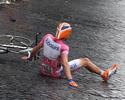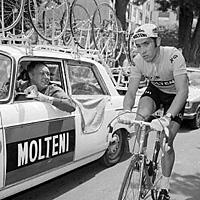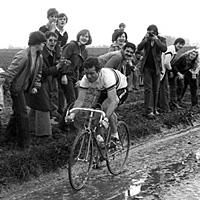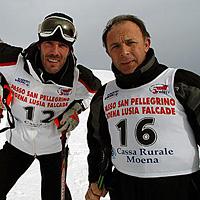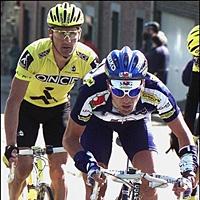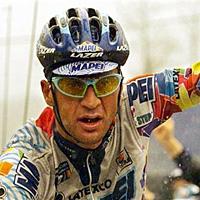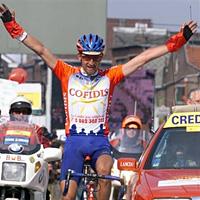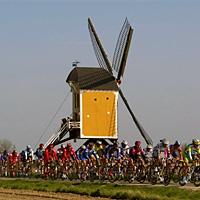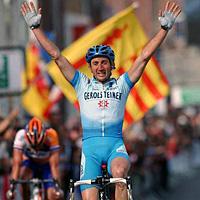
Recently on Cyclingnews.com |
Tales from the peloton, April 16, 2009
Great moments in Classics history – the Ardennes Classics
By Cyclingnews staff
You've seen us get sentimental over our favourite cobbled Classics moments, but with those events run and won, Cyclingnews reminisces on some of the great Ardennes classic moments. Amstel Gold Race, La Flèche Wallonne and Liège-Bastogne-Liège make up the Ardennes Classics and are also the final Spring Classics of 2009, so join us as we take a trip down memory lane for some of the big moments and bizarre stories that have cemented this trio's Classics status.
1957 Liège-Bastogne-LiègeOne race, two winnersBy Greg Johnson In a sport focused on man-power, it's amazing how many times other vehicles come crashing into the history books. Even more surprising is that more often than not it's a train, rather than a car or motorbike, that causes unusual situations and impacts the results in cycling. For instance in 2006 it was a train that caused havoc at Paris-Roubaix when the race and train timetables collided. Fortunately none of the riders collided with the train, but skipping through the boom when it was shot cost Peter Van Petegem (Davitamon-Lotto), Vladimir Gusev (Discovery Channel) and Leif Hoste (Discovery Channel) their results. More recently a motorbike plunged into the crowd at this year's Paris-Roubaix, while if you throw the clock back nearly 100 years Luigi Ganna was disqualified from Milan-Sanremo for completing the closing kilometres in a car. If you meet somewhere in the middle of those two times, and add another train, you get the curious outcome of the 1957 Liège-Bastogne-Liège. Just over 50 years ago two riders 'shared' the victory: Frans Schoubben (Elvé-Peugeot) and Germain Derycke (Faema-Guerra). While they didn't benefit from today's split second timing back then, the riders actually finished minutes apart. So how did two riders win the race? Derycke was the first rider to cross the line, by more than three minutes, however officials discovered that – like Roubaix in 2006 – he had crossed through a closed train crossing. This discovery saw organisers elevate Schoubben to first place, technically claiming the race victory. However, as Derycke enjoyed a comfortable margin at the finish, more than they felt he'd gained by crossing when he shouldn't have, the Belgian rider wasn't actually disqualified from the race. And so, that's how Derycke ended up the first classified rider, but compatriot Schoubben claimed the win. |
1969, 1971, 1972, 1973, 1975 Liège-Bastogne-LiègeFive of Merckx's finestBy Greg Johnson
There's been many great Ardennes moments over the years, but here we'd like to pay tribute to one man and his many Ardennes moments. Eddy Merckx is that man and Liège-Bastogne-Liège is the setting, but we're not looking at just one moment. No, during his comprehensive professional career Merckx won the event five times. Sure, Moreno Argentin has four wins, Fred De Bruyne three and both Paolo Bettini and Michele Bartoli have two a piece. But nobody has been able to match Merckx's mystical five victories during the event's 93 editions. Merckx took his first top 10 finish at Liège in the early stages of his career in 1966, when he finished eighth. The following year he finished on the podium in second place, but it wasn't until two years later, in 1969, when Merckx claimed his first Liège win. By this point in the Belgian's career Merckx was a World Road Champion, a Giro d'Italia winner and just weeks away from winning his first Tour de France. It was the beginning of what would be a beautiful and successful association with his home monument, despite settling for third the following year. When Merckx claimed his second victory at the race in 1971 it was the first of three back-to-back wins at the Ardennes classic. The rider's fifth and final victory in Liège came two years later, in 1975. Of course Liège wasn't the only site of Merckx's Ardennes success. He won La Flèche Wallonne in 1967, 1970 and 1972 and also took out the Amstel Gold Race in the Netherlands in 1973 and 1975. |
|||
1981 Amstel Gold RaceOne day only for the BadgerBy Les Clarke
Prior to 1981 Bernard Hinault hadn't shown much interest in riding the Classics. His attitude seemed to change in April of that year when he won Paris-Roubaix. The next month the Frenchman made his way to the Ardennes region of southern Belgium to contest the tough, hilly one-day races, where general classification riders such as Hinault aren't out of place. That's because events such as Amstel Gold Race act as great preparation for the Grand Tours later in the season, and with the Tour de France looming as a major goal for Hinault, he wasn't an exception to that trend. On the day however, organisers were worried that fog may compromise safety for competitors, which effectively ensured that the racing wouldn't begin in earnest until late in the event. Hinault won in a tight sprint against four-time Roubaix victor Roger de Vlaeminck after 16 punishing climbs, with Fons de Wolf rounding out the podium. As such, the legacy left by the 1981 edition of this race is the illustrious list of riders who competed that year. The racing may have been truncated somewhat, but the startlist certainly wasn't. Some of those featured on it are now organisers of the sport at the highest level, such as Jean-François Pescheux, while others such as Gilbert Duclos-Lassalle, Rudy Pevenage and Theo de Rooij have been involved in team management at various times over the past decade. Add the likes of Roger de Vlaeminck, Phil Anderson, Sean Kelly and Jan Raas, and the field for the 1981 Amstel Gold Race was as good as any that has contested the 250 kilometres of punishing bergs on narrow roads before or since. Hinault didn't feature in the race's history after his one victory, bucking the trend of 'loyalty' that riders who excel in the Ardennes Classics have towards the races where they write their names into history. |
1987 Liège-Bastogne-LiègeArgentin's unlikely three-peatBy Peter Hymas
It's not every day that a pair of champion cyclists fritter away sure victory in one of the Monuments, but that's exactly what happened to Stephen Roche and Claude Criquielion in the bizarre endgame of 1987's Liège-Bastogne-Liège. With approximately 10 kilometres of racing left in La Doyenne, Roche and Criquielion enjoyed a comfortable one minute cushion over their nearest rivals. Satisfied that their competition had been readily dispatched, the Irishman and Belgian entered a lengthily protracted war of nerve and restraint on the streets of Liège. Kilometre after kilometre the duo eyed each other warily, sometimes riding side-by-side, sometimes riding in each other's draft, their pace slowing dramatically. It was as if their duel had been removed from the road and transplanted to a velodrome match sprint. Criquielion certainly was confident in his form, with a crushing solo victory in the Ronde van Vlaanderen two weeks before and a second in the La Flèche Wallonne four days prior. Roche, too, was feeling good, fully recovered from his knee surgery the previous autumn, building fitness for what would be his historic 1987 Triple Crown. Two years previously, in the 1985 edition, the same duo was part of the winning three-man break. Unfortunately for Roche and Criquielion, the third member of the trio that day was Italian Moreno Argentin, who dutifully dispatched them with a burst of speed neither could match. Criquielion finished second, Roche third. Surely 1987 would be different for Roche and Criquielion, with Argentin out of the picture. Or so they thought. Three riders, Yvon Madiot, Robert Millar, and yes, Moreno Argentin, the reigning World Road Champion, hadn't thrown in the towel. Astonishingly, they made contact with the leading duo at 300 metres to go just as Criquielion led out the sprint. Yet again, the pair had no answer for Argentin, who rocketed to his third consecutive Liège-Bastogne-Liège victory, the last rainbow-striped jersey wearer to win. Roche finished second, Criquielion third, and neither would ever taste victory in La Doyenne. |
|||
1997 Liège-Bastogne-LiègeBartoli brilliant in LiègeBy Daniel Benson
By the end of the 1996 season Michele Bartoli had cemented his place as one of the best one day racers in the world. However during the first World Cup races of 1997, the Italian failed to claim the next big win his palmarès cried out for, with a crash-effected Milan-Sanremo finishing in a bunch sprint and Rolf Sørensen stealing the show in Flanders. The pressure on the MG-Technogym rider's shoulders was building. All that changed on a sunny April day in Liège. The scene was perfect, with the conditions combing with one of the most illustrious start lists any Classic from the era could hope for – Johan Museeuw, Mauro Gianetti, Laurent Jalabert, Marco Pantani, Rolf Sørensen, Alex Zülle and Chris Boardman. The real action began with 50 kilometres remaining, as the peloton reached La Redoute, one of the race's most historic and often influential climbs, and Bartoli's henchmen began to gather at the front. What ensued was one of the finest displays of tactical racing the event had seen. It was the sparked by the bespectacled Zülle, who launched the first serious dig. He was quickly followed by Bartoli and Pantani and Jalabert, as the World Champion Museeuw and Sørensen were forced onto the back foot. Pantani – still recovering from his horrific crash – was dropped as the trio pushed the gap out to a minute. Bartoli, now sandwiched between the ONCE teammate, and top two riders in the world played his cards majestically, first chasing attacks and then countering the Frenchman. It was this counter that did Zülle in, his confidence now shot, as Bartoli pushed again, to consign the Swiss rider to 41st place. With the final kilometre now in sight, Bartoli looked across at Jalabert, who by now was unable or unwilling to make eye contact. Bartoli saw his moment and swooped, leaving the world number one and crossing the line alone in Liège. Bartoli went on to lead the Giro d'Italia that year, but his career will always be associated with that day and the panache he displayed in beating two of the biggest stars in cycling. |
1999 La Flèche Wallonne'Soft' Bartoli wins hard raceBy Bjorn Haake
The 1999 La Flèche Wallonne was held in tough conditions, with temperatures a chilly three degrees Celsius and rain complimented by snowfall. Michele Bartoli prevailed in those atrocious conditions but said that earlier in his career he would have ridden with less clothing, admitting that he had gotten a touch 'soft'. Such toughness would never occur to Oscar Camenzind, who was wearing a vest until he figured it would be best to remove it for the finale. The only problem was Camenzind got his zipper stuck. Bartoli and Maarten den Bakker waited for a while as Camenzind went to his car to get his clothing problem sorted out. Apparently scissors aren't part of the 'must have' toolbox in the team car. Eventually Bartoli and Den Bakker couldn't wait any longer and reached the Mur de Huy together, without the Swiss dressman. Bartoli sprinted away on the steep climb, with pitches up to 25 percent, and won by a good dozen seconds.
After Camenzind's fixed his zipper problem, he continued by himself and almost held off the peloton behind. Only Mario Aerts was able to slip past the Swiss rider for third place. Bartoli deserved the win as he was the strongest rider, having initiated the decisive three-man move on the second time up the Mur de Huy (out of three total ascents). Bartoli, Camenzind and Den Bakker worked well together and by the time Camenzind fell apart (or his clothing did, anyway) the gap was almost three minutes, some 50 kilometres from the finish. |
|||
1999 Liège-Bastogne-LiègeVandenbroucke explodes race on RedouteBy Gregor Brown
Frank Vandenbroucke claimed his first big Spring Classic win in dramatic style at the 1999 Liège-Bastogne-Liège, thanks to a lethal attack on the Côte de la Redoute. The Belgian battled all of cycling's greats over the 2200-metre climb amidst throngs of fans and under sunny skies. The Mapei-led peloton caught solo escapee Laurent Jalabert prior to the climb, the seventh of 10 that year. Mapei's Axel Merckx, son of cycling great Eddy, took over the pace making to drop teammate Michele Bartoli's rivals in the first moment of the climb. While the likes of Davide Rebellin (Polti) and World Champion Oscar Camenzind (Lampre) were edging to the front, it was Bartoli himself who took the initiative to attack. The Italian quickly made five metres on a group of rivals led by Dutch Champion Michael Boogerd (Rabobank). Vandenbroucke, then with Cofidis, opened the throttle completely when the Boogerd-led group caught Bartoli. The Italian and Belgian dueled side-by-side for some time before Vandenbroucke over-powered him on the right just after the barriers ended. The attack proved his victories in the 1998 Paris-Nice and Het Volk earlier that year were no fluke. A group of near 15 riders caught the lone Vandenbroucke after the top, but he had enough confidence from that move to easily put a gap into Boogerd for the win in Ans 35 kilometres later. |
2003 Amstel Gold RaceA classic comes of ageBy Laura Weislo
The youngest of the Spring Classics has always suffered from "middle child syndrome". It lacks the long kilometres of pave of the earlier Spring Classics, and yet the climbs are not as long and selective as those of Liège-Bastogne-Liège and La Flèche Wallonne. For years the race struggled to gain the prominence of these Monuments. That all changed in 2003 when the Dutch race swapped places on the calendar with Liège, and seated itself as the proper transition event from the hell of Paris-Roubaix to the torturous Ardennes Classics. The race also got a much needed change to the finish, shifting east from Maastricht to the cycling hotbed of Valkenburg. By moving the finish to the top of the Cauberg, a climb already made famous by its inclusion in the World Championships as well as being an intermediate climb in the Amstel Gold Race itself, the character of the race changed dramatically. The race still had so many climbs and turns it more resembled a roller coaster than a bike race, but now instead of a flat run of 8-10km to the finish line, it had a 500 metre kicker (12 percent gradient) with a lung-busting 800 metre false flat. The changed basically ruled out any possibility of a bunch sprint like the one that Erik Zabel rode to victory in 2000. The inaugural finish saw an emotional Alexandre Vinokourov deliver a fitting tribute to his fallen comrade Andrei Kivilev by winning after a heroic five kilometre solo breakaway. The Kazakh also relegated hometown favourite Michael Boogerd to one of his four runner-up finishes. |
|||
2004 Amstel Gold Race, La Flèche Wallonne and Liège-Bastogne-LiègeRebellin's Triple CrownBy Susan Westemeyer
Davide Rebellin dominated the Ardennes Classics while riding for Gerolsteiner in 2004 in a way no other rider ever has. The Italian became the first and only rider to win the Amstel Gold Race, La Flèche Wallonne and Liège-Bastogne-Liège, all in just seven days. Rebellin, 32 years old at the time, had only recently recovered from a parasitic infection that had dogged him for two years. He used his good health's return to put his unmistakable stamp on the later Spring Classics. At Amstel Rebellin and Michael Boogerd (Rabobank) broke out of a six-man escape group on the Fromberg with 17 kilometres to go. Boogerd, who had been on the event's podium five times, opened the sprint on the closing Cauberg with 350 metres to go, but Rebellin passed him with 100 metres to go to take the win by one second. Three days later Rebellin won La Flèche Wallonne in similar style, sprinting to the top of the Mur de Huy. His victim this time was Danilo De Luca (Saeco), whom Rebellin again passed with100 metres to go, to take the win this time by three seconds Rebellin crowned his performance by winning the oldest of the Classics, Liège-Bastogne-Liège. It was Boogerd once again who succumbed to Rebellin, this time by two seconds. "Incredible, unbelievable," said Rebellin of his triple treat. "Three races that I have dreamed of since I was a child. Three races that up until now I had only finished with podium places. I came again to the north to try and finally win one. Now I've won all three in a week. It's completely incredible!" |
2005 La Flèche WallonneDi Luca does the doubleBy Hedwig Kröner
In cold and damp weather conditions – typical for the Ardennes region of Belgium at that time of year – Italian rider Danilo Di Luca came out of a decimated bunch on the famed Mur de Huy to take his second 2005 Spring Classic in a row. Just a few days after his Amstel Gold Race victory in the Netherlands, "the Killer" struck again as he out-sprinted his most dangerous rivals like Kim Kirchen and Davide Rebellin, showing tremendous strength on the final climb. Before the start, Di Luca had told Cyclingnews that he intended to attack prior to the last ascent, and was actually more focused on Liège-Bastogne-Liège than the Flèche. In the end, he 'controlled' his rivals at the foot of the Mur, and set things up to repeat Rebellin's historical triple of the previous year. That he didn't quite succeed (Di Luca finished 27th in Liège-Bastogne-Liège four days later) only proved how great his power output was that day. Second-placed behind Rebellin in 2004, Di Luca moreover avenged his defeat against his countryman this time around, which must have been particularly satisfying. Little did he know that he was going to win the third of the Ardennes Classics – Liège-Bastogne-Liège, the most precious one of the three – two years later, in 2007. By winning the 2005 Flèche, Di Luca certainly proved he was one of the best and gained important confidence to extend his palmarès further. |
Photography
For a thumbnail gallery of these images, click here
Images by AFP Photo
- Eddy Merckx and son Axel did a charity ride at Liège-Bastogne-Liège in 2004.
- Eddy Merckx rides in the 1971 Tour de France.
Images by AFP Photo
- Bernard Hinault didn't feature in the race's history after his one victory.
Images by Nordmilch
- Mario Cipollini and Moreno Argentin enjoy their time competing in the Cycling-Ski Challenge.
Images by AFP Photo
- Michele Bartoli rides with Laurent Jalabert just before putting his foot down and simply riding away to victory in 1997.
Images by AFP Photo
- Michele Bartoli wins La Flèche Wallone on a cold day in the snow fall.
Images by AFP Photo
- Like most things in Frank Vandenbroucke's life, his 1999 Liège-Bastogne-Liège win came in dramatic style.
- The Amstel Gold Race came of age in 2003 after years fighting for true Ardennes classic status.
- With victory salutes like Alexandre Vinokourov's how could you not be impressed by the 2003 edition of Amstel Gold Race.
Images by Olympia Photo
- Davide Rebellin (Gerolsteiner) claims his third race in a week and takes the World Cup lead at Liège.
Images by Mani Wollner/www.foto-grafik-satz.de
- Micahel Boogerd, Davide Rebellin and Alexandre Vinokourov battling it out in the closing kilometres of Liège-Bastogne-Liège.
Images by AFP Photo
- Danilo Di Luca (Liquigas) beats Kim Kirchen to win La Flèche Wallonne.
Images by Sirotti/www.sirotti.it
- Danilo Di Luca (Liquigas) wins La Flèche Wallonne in 2005.
